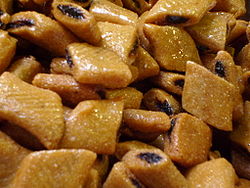Makroudh
 Makroudh covered in honey | |
| Type | Cookie |
|---|---|
| Place of origin | Maghreb |
| Main ingredients | Semolina, dates or figs[1] |
Makroudh (Arabic: مقروض, romanized: maqrūḍ), also spelled Makrout, is a cookie from the cuisine of the Maghreb. It is filled with dates and nuts or almond paste, that has a diamond shape[2] – the name derives from this characteristic shape.
The dough is made with a combination of semolina and flour, which gives the pastry a very specific texture and flavor. Makroudh can be fried in oil or oven-baked.[3]
It is popular in the Maghreb where there are many varieties of Makroudh, some of which are pastries that do not share much in common with the traditional Makroudh except the shape.[4][5] In Algeria, they may be filled with almond paste.[6] A variation with a fig filling in place of the dates is popular in Tunisia and Algeria.[7][1]
Makroudh with dates and honey is also popular during Eid al-Fitr.[8]
History
[edit]According to historian Daniel Newman, the oldest known recipe for maqrud dates back to a 13th-Century Arabic cookbook by Ibn Razīn al-Tujībī.[9] The recipe describes date-filled, fried dough.[10]
Preparation
[edit]Makroudh is prepared by filling a dough made with semolina, usually using the Deglet Nour date variety. The dough is then rolled and cut into diamond-shaped pieces. The pastry is then either fried or oven-baked. The final step involves soaking the makroudh in a sweet syrup.[11][12]
See also
[edit]References
[edit]- ^ a b "Makroud: Algeria's sweet symbol of tradition and family". The Sudan Times. 22 September 2024. Retrieved 14 September 2025.
- ^ "Tunisian Makroudh, Date-Filled Semolina Cookies". Carthage Magazine. 28 December 2023. Retrieved 14 September 2025.
- ^ Gaelle & Patrice Le Franc. "Makroudh". La Cuisinede Ma Copine. Archived from the original on 2012-07-08. Retrieved 2014-04-09.
- ^ "Makrout el louz - Les Joyaux de Sherazade". Les Joyaux de Sherazade (in French). 2015-07-16. Retrieved 2017-06-19.
- ^ "Recette pour ramadan facile / Makrout salé". Les Joyaux de Sherazade (in French). 2014-05-29. Retrieved 2017-06-19.
- ^ Marks, Gil (2010-11-17). Encyclopedia of Jewish Food. Houghton Mifflin Harcourt. ISBN 978-0544186316.
- ^ "تين "دجبّة" التونسي.. من أعالي الجبال إلى متناول العالم" [Tunisian "Djebba" figs: from the high mountains to the world's reach (report)]. Anadolu Agency. 7 Sep 2023. Retrieved 14 September 2025.
- ^ Jacob, Jeanne; Ashkenazi, Michael (2014). The World Cookbook: The Greatest Recipes from Around the Globe. ABC-CLIO.
- ^ Al-Tujībī, Ibn Razīn (8 August 2023). The Exile's Cookbook: Medieval Gastronomic Treasures from al-Andalus and North Africa. Translated by Newman, Daniel. Saqi Books. ISBN 978-0-86356-997-5. Retrieved 20 September 2025.
- ^ Newman, Daniel (15 July 2019). "Maqrud (مَقْرُوض)". Eat Like A Sultan. Retrieved 20 September 2025.
- ^ "North African Cuisine". www.foodingredientsonline.com. Retrieved 2018-02-05.
- ^ Oliveira, Ghaya (2 December 2015). "Tunisian Makroud (Date-Filled Semolina Cookies)". Saveur. Retrieved 14 September 2025.
